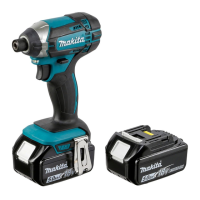Fig.11
The proper fastening torque may differ depending upon
the kind or size of the screw/bolt, the material of the
workpiece to be fastened, etc. The relation between fas-
Proper fastening torque for standard bolt
120
100
80
60
40
20
M14
M12
M10
M8
N•m
2
1
(kgf•cm)
(1224)
(1020)
(816)
(612)
(408)
(204)
0
140
(1428)
123
M16
M16
M14
M12
M10
M8
1. Fastening time (second) 2. Fastening torque
Proper fastening torque for high tensile bolt
0
123
M12
M10
160
(1632)
140
(1428)
120
(1224)
100
(1020)
80
(816)
60
(612)
40
(408)
20
(204)
M8
M12
M10
M8
N•m
(kgf•cm)
2
1
1. Fastening time (second) 2. Fastening torque
in the screw head. Apply forward pressure to the tool to
the extent that the bit will not slip off the screw and turn
the tool on to start operation.
NOTICE: If you use a spare battery to continue
the operation, rest the tool at least 15 min.
NOTE: Use the proper bit for the head of the screw/
bolt that you wish to use.
NOTE: When fastening M8 or smaller screw, carefully
is not damaged.
NOTE: Hold the tool pointed straight at the screw.
NOTE: If the impact force is too strong or you tighten
the screw or the point of the driver bit may be over-
stressed, stripped, damaged, etc. Before starting your
proper fastening time for your screw.
The fastening torque is affected by a wide variety of
factors including the following. After fastening, always
check the torque with a torque wrench.
1. When the battery cartridge is discharged almost
completely, voltage will drop and the fastening
torque will be reduced.
2. Driver bit or socket bit
Failure to use the correct size driver bit or socket
bit will cause a reduction in the fastening torque.
3. Bolt
class of bolt are the same, the proper fasten-
ing torque will differ according to the diame-
ter of bolt.
• Even though the diameters of bolts are the
same, the proper fastening torque will differ
of bolt and the bolt length.
4. The manner of holding the tool or the material
of driving position to be fastened will affect the
torque.
5. Operating the tool at low speed will cause a reduc-
tion in the fastening torque.
MAINTENANCE
CAUTION: Always be sure that the tool is
switched off and the battery cartridge is removed
before attempting to perform inspection or
maintenance.
NOTICE: Never use gasoline, benzine, thinner,
alcohol or the like. Discoloration, deformation or
cracks may result.

